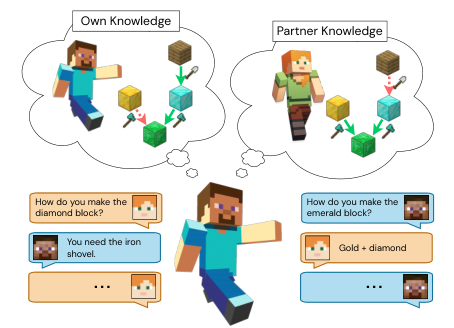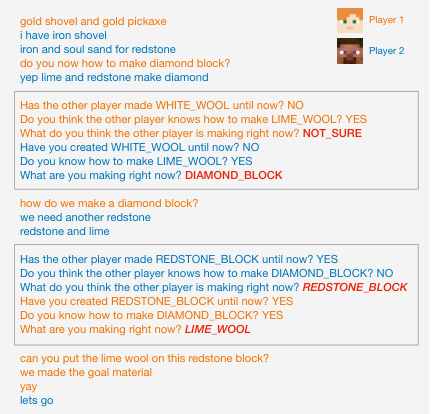Limits of Theory of Mind Modelling in Dialogue-Based Collaborative Plan Acquisition
Matteo Bortoletto, Constantin Ruhdorfer, Adnen Abdessaied, Lei Shi, Andreas Bulling·May 21, 2024
Summary
This study investigates the role of Theory of Mind (ToM) modeling in dialogue-based collaborative plan acquisition (CPA) within a Minecraft environment. While previous research suggested ToM could enhance missing knowledge prediction, particularly for partners with unequal skills, the authors find that improvements due to ToM modeling are limited. Performance in CPA is significantly higher when predicting one's own missing knowledge compared to a partner's, and baseline models with ToM features perform similarly without them. The results indicate that ToM features might capture dataset patterns rather than reflecting true ToM abilities, necessitating a deeper understanding of ToM's role in collaborative AI and the need for alternative methods to model mental states in agents.
The study proposes a graph-based representation for dialogue-based CPA, outperforming previous works by representing plans as directed graphs. However, it discovers no significant difference in performance when using ToM features, suggesting that learned features may not directly correspond to mental states. The research contributes by enhancing plan prediction and questioning the current understanding of ToM in collaborative tasks, suggesting that current models might rely on dataset biases.
The research combines various aspects, including training models to predict players' mental states, knowledge, and intentions, and examining the Common Partner Awareness (CPA) task. It evaluates a GNN-based model with Graph Attention layers and a Transformer for ToM, using candidate sampling to refine predictions. While the model shows improvements in some tasks, it falls short in accurately capturing temporal aspects and mental states.
The study finds that ToM features do not significantly enhance CPA performance, and there is a lack of strong correlation between ToM task performance and CPA. It suggests that current approaches to modeling mental states in collaborative agents might be insufficient and calls for more general world models and interpretable methods. The research is set in the context of Minecraft, a popular game for studying human-like collaboration and problem-solving, and highlights the importance of ethical considerations in AI that model human cognition.
Introduction
Background
Previous research on ToM and CPA in collaborative tasks
Importance of Minecraft as a research environment
Objective
Investigate the impact of ToM modeling on CPA performance
Examine the limitations of current ToM models in AI collaboration
Method
Data Collection
Minecraft-based dialogue dataset for collaborative plan acquisition
Inclusion of ToM, knowledge, and intention data
Data Preprocessing
Graph-based representation of plans
Feature extraction, including ToM features
Model Architecture
Graph Neural Network (GNN) with Graph Attention Layers
Description and implementation
Transformer for Theory of Mind
Integration and evaluation
Evaluation Metrics
CPA task performance
Comparison with and without ToM features
Candidate Sampling
Technique for refining predictions
Results and Analysis
Performance Comparison
CPA with own vs partner's missing knowledge prediction
Baseline models with and without ToM features
ToM Features and Dataset Bias
Lack of significant improvement with ToM modeling
Indication of dataset patterns rather than true ToM abilities
Temporal and Mental State Capture
Model limitations in capturing temporal aspects and mental states
Correlation Analysis
Weak relationship between ToM task performance and CPA
Discussion
Current Understanding of ToM in Collaborative AI
Relevance of learned features to mental states
Dataset biases and their impact
Alternative Approaches
Suggestions for general world models and interpretable methods
Ethical Considerations
Importance in AI that models human cognition, especially in Minecraft
Conclusion
Limitations of ToM modeling in dialogue-based CPA
Necessity for reevaluation and development of mental state modeling in collaborative agents
Basic info
papers
artificial intelligence
Advanced features
Insights
What is the proposed graph-based representation for dialogue-based CPA, and how does it compare to previous works in terms of performance?
What is the primary focus of the study regarding Theory of Mind (ToM) in dialogue-based collaborative plan acquisition (CPA) within Minecraft?
What are the limitations and suggestions raised by the research regarding the current understanding and modeling of mental states in collaborative AI agents?
How does the study's findings challenge previous beliefs about the impact of ToM on missing knowledge prediction, especially in unequal skill partnerships?




